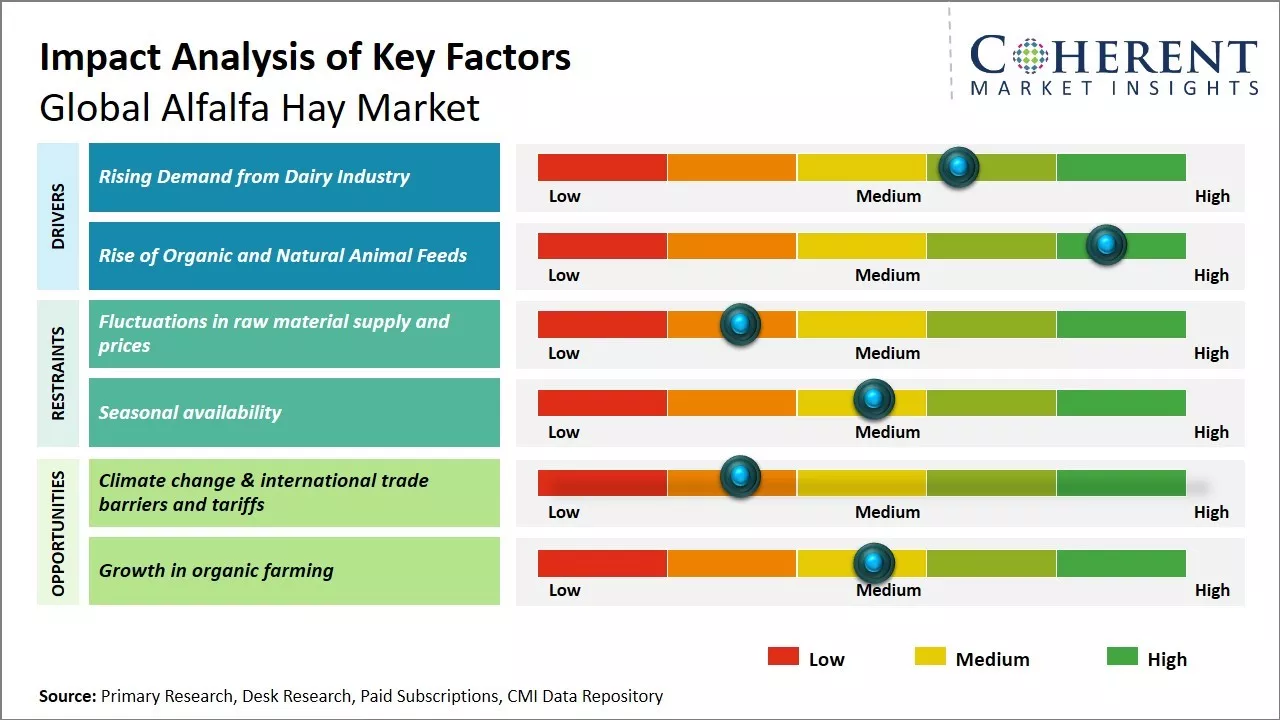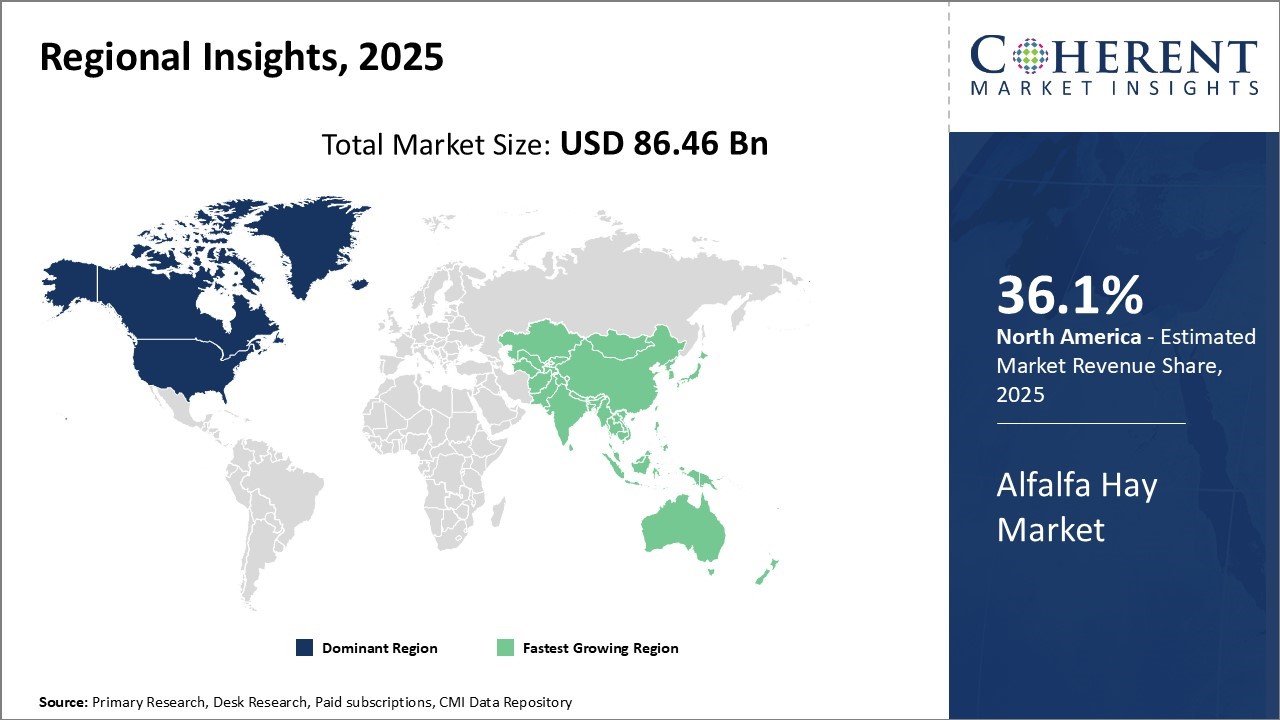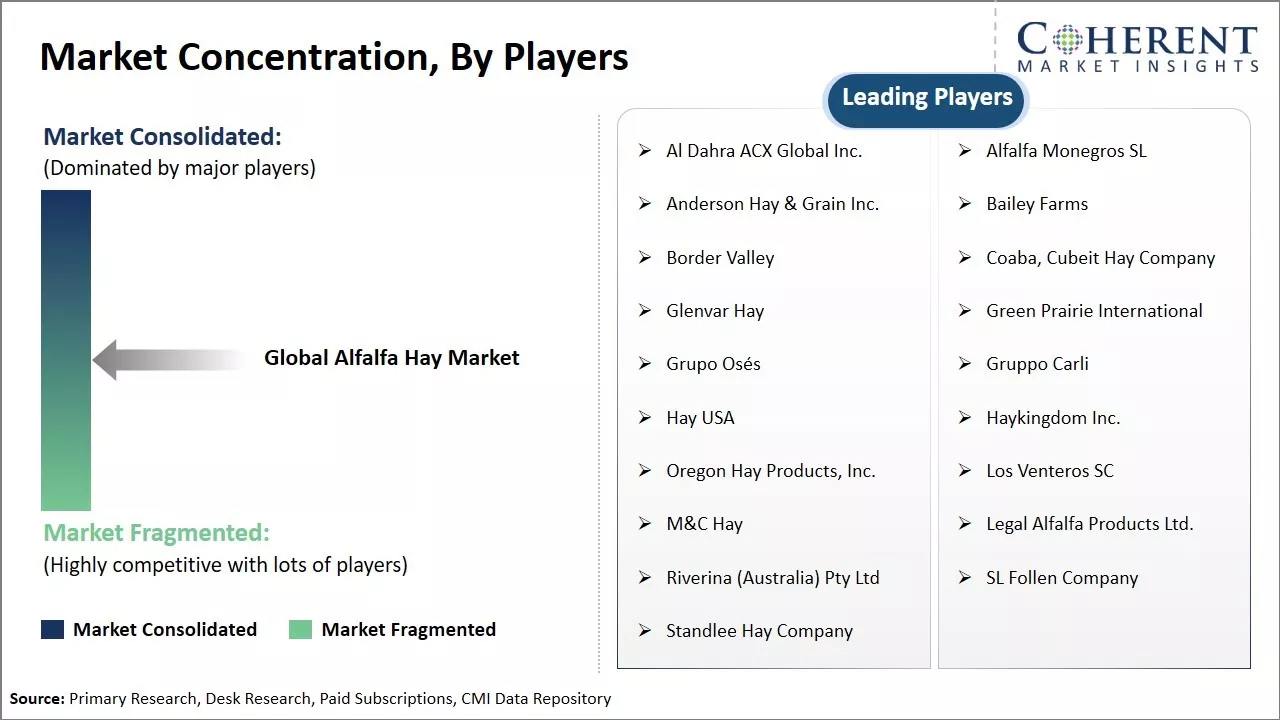The global alfalfa hay market is estimated to be valued at USD 86.46 Bn in 2025 and is expected to reach USD 136.22 Bn by 2032, growing at a compound annual growth rate (CAGR) of 6.7% from 2025 to 2032.

To learn more about this report, Download Free Sample
The alfalfa hay market is witnessing steady growth driven by increasing demand for high-quality animal feed across dairy, beef, and equine sectors. Its rich protein, fiber, and digestibility make it a preferred forage crop, especially in developed agricultural economies like the U.S., Canada, and parts of Europe. The rising livestock productivity targets and expansion of organized dairy farms in Asia-Pacific and the Middle East are further boosting demand. Technological advancements in harvesting and storage are enhancing hay quality and shelf life. Additionally, global trade is expanding, with the U.S. and Spain being major exporters to Asia and the Gulf region.
|
Current Events |
Description and its impact |
|
Technological Adaptation Pressures |
|
|
Policy-Driven Market Interventions |
|
|
Dairy Industry Demand Shifts |
|
|
Severe Drought Conditions in Key Production Regions |
|
Uncover macros and micros vetted on 75+ parameters: Get instant access to report
Between August 2023 and July 2024 (TTM), India exported 2 shipments of Alfalfa Hay. These exports were carried out by a single Indian exporter and delivered to two different buyers.
In July 2024 specifically, India recorded 2 Alfalfa Hay export shipments, representing a 2% increase year-over-year from July 2023 and a 2% rise compared to June 2024.
Among the various types of alfalfa hay, including bales, pellets, and cubes available in the market, pellets have emerged as the dominant form, accounting for the largest share, which is expected to account for 57.2% of the market share in 2025. There are multiple factors that have led to the popularity and higher adoption of alfalfa hay pellets over other types. Pellets provide a longer shelf life as compared to loose or baled hay due to their dense structure, which prevents air exposure and moisture penetration. This extended shelf-life allows pellets to be stored for longer durations without quality deterioration. Furthermore, the uniform size and density of pellets enable consistent intake and accurate feeding amounts for animals. The precise and controlled feeding facilitated by pellets minimizes feed wastage and ensures balanced nutrition intake. Also, pellets have lower transportation and warehousing costs relative to other types due to their high density and ability to be packed efficiently without airspaces in containers and warehouses. For instance, Andy by Anderson Hay™ and Belstra's Heinold®Feeds, have collaborated to create custom Alfalfa-based feed Pellets for young rabbits. This is further propelling the alfalfa hay market share.
Within the various application segments where alfalfa hay is utilized, daily animal feed has emerged as the largest segment globally, and it is expected to account for 37.3% of the market share in 2025. This dominant position is attributed mainly to the massive consumption of alfalfa hay in the dairy and cattle breeding industries. Dairy farming requires high-quality and nutrient-rich fodder to maximize milk yields from cows. Alfalfa hay is rich in proteins, minerals, and vitamins essential for dairy cows and has been demonstrated to boost milk production considerably when used as a major feed component. Similarly, in cattle breeding, high-performance alfalfa hay is invaluable for supporting the nutritional needs of beef and dairy cattle and enabling healthy growth at different life stages. The expanding global populations in these industries have therefore stimulated growing demand for alfalfa hay specifically targeted for daily animal feed use.
Additional growth in this segment is attributed to the rising living standards and protein consumption, driving continuous growth in the dairy and meat sectors. Together, these industry-level trends have made daily animal feed the leading application segment within the overall alfalfa hay market landscape. For instance, Gramik launched cattle feed supplements in India, which include "Doodh Sagar" for lactating cattle, "Heifer Mix" for young female cattle, and "Urja Pashu Poshak Aahar" for energy and reproductive health. Such innovations are accelerating the alfalfa hay market growth.

To learn more about this report, Download Free Sample
North America has established itself as the dominant region in the global alfalfa hay market over the past few decades. The region is expected to account for 36.1% of the market share in 2025. The U.S., in particular, accounts for the prominent share of the market in the region, given the widespread use of alfalfa as a major feed for cattle.
Major alfalfa-producing states such as California, Wisconsin, and Pennsylvania in the U.S. generate huge volumes that are primarily consumed locally by the large dairy and beef industries present across the country. Alfalfa is a preferred choice of farmers owing to its high nutritional value and the ease of cultivation in the fertile lands of the Midwest. For instance, according to the USDA, alfalfa hay production in 2023 reached 70.1 million metric tons, up from 64.8 million metric tons in 2022. The leading states in alfalfa production include California, Idaho, Montana, South Dakota, and Arizona.
On the other hand, Asia Pacific has emerged as the fastest-growing regional market for alfalfa hay globally over recent years. China leads the Asia Pacific pack and is ramping up imports significantly to supplement domestic production and meet the burgeoning demand from its massive livestock industries. Growth is being further propelled by countries like India, Vietnam, and Indonesia, as rising incomes and urbanization are translating to increasing meat consumption. The push for more sustainable and advanced animal farming techniques has also boosted demand. For instance, the Indian company SERVODAY has established an innovative plant in Chitrakoot, Uttar Pradesh, that transforms locally sourced alfalfa into fuel pellets, providing a sustainable energy alternative.
Several factors are helping the growth of the United States alfalfa hay market. The growing demand from the dairy and livestock industries, due to the need for high-protein, healthy animal feed, is a major reason. More export deals, especially with countries in Asia and the Middle East, have also added to the market’s growth. Improvements in farming tools and methods have made it easier to produce better-quality hay and store it well. In addition, helpful government policies and growing interest in eco-friendly farming are encouraging more farmers to grow alfalfa. Together, these factors are making the market stronger at home and abroad. For instance, Bailey Farms International has expanded its alfalfa drying facilities in the U.S. to produce better-quality hay pellets. They recently signed agreements with livestock farms in the Middle East and invested in solar-powered drying systems to reduce their impact on the environment.
The growth of India’s alfalfa hay market is mainly due to the rising need for good-quality animal feed, especially in the dairy and livestock industries. As milk production increases to meet both local and export demand, farmers are choosing nutrient-rich feed like alfalfa to improve animal health and milk output. More people now understand the benefits of alfalfa’s high protein and fiber. Government support for better cattle nutrition also helps increase demand. The rise of large dairy farms and better methods for cutting and storing forage are strengthening the supply. Also, imports during dry seasons show alfalfa’s growing role in Indian farming. For instance, the state of Punjab in India is aiming to boost livestock productivity through alfalfa cultivation, highlighting its potential to address fodder scarcity and improve soil health. Such initiatives are proliferating the alfalafa hay market demand.

To learn more about this report, Download Free Sample
| Report Coverage | Details | ||
|---|---|---|---|
| Base Year: | 2024 | Market Size in 2025: | USD 86.46 Bn |
| Historical Data for: | 2020 To 2024 | Forecast Period: | 2025 To 2032 |
| Forecast Period 2025 to 2032 CAGR: | 6.7% | 2032 Value Projection: | USD 136.22 Bn |
| Geographies covered: |
|
||
| Segments covered: |
|
||
| Companies covered: |
Al Dahra ACX Global Inc., Alfalfa Monegros SL, Anderson Hay & Grain Inc., Bailey Farms, Border Valley, Coaba, Cubeit Hay Company, Glenvar Hay, Green Prairie International, Grupo Osés, Gruppo Carli, Hay USA, Haykingdom Inc., Oregon Hay Products, Inc., Los Venteros SC, M&C Hay, Legal Alfalfa Products Ltd., Riverina (Australia) Pty Ltd, SL Follen Company, and Standlee Hay Company |
||
| Growth Drivers: |
|
||
| Restraints & Challenges: |
|
||
Uncover macros and micros vetted on 75+ parameters: Get instant access to report
Key factors, including increasing demand from the dairy industry for cattle feed and a rising preference for organic and healthy animal feed among livestock owners, are fueling market growth. Alfalfa hay is a rich source of vitamins, minerals, and protein that helps improve immunity, digestion, and milk production in dairy animals.
Additionally, growing awareness among consumers about the benefits of alfalfa hay has encouraged livestock farmers and feed producers to incorporate alfalfa into compound cattle feed, which, in turn, is boosting global demand for alfalfa hay. Moreover, the expansion of organic farming and rising consumption of organic dairy products have surged the demand for organic alfalfa hay over the recent years. However, the high cost of production and fluctuations in seasonal harvest may hamper the market growth during the forecast period.
The global dairy industry has been growing substantially over the past few decades, driven by rising incomes in developing countries and changing dietary habits. Alfalfa hay is one of the most preferred and nutritious feeds for dairy cows as it is highly digestible and contains important nutrients like proteins, vitamins, and minerals. Alfalfa hay helps improve milk production in cows by increasing dry matter intake and boosting cow health.
With more people consuming dairy products worldwide, dairy farmers are expanding their operations and livestock numbers to cater to the growing demand. This has created a strong demand for high-quality animal feeds like alfalfa hay across major dairy animal rearing regions. Regions with large dairy sectors like North America, Europe, and the Asia Pacific are major markets for alfalfa hay. Considering the projected continued growth of the dairy industry in the coming years, supported by growing populations and consumer incomes, the demand for alfalfa hay from dairy farms is expected to rise at an even faster pace.
The expanding meat and dairy industries across the globe are creating a rising demand for animal feed, which can prove to be a great opportunity for the Global Alfalfa Hay Market. Countries like China, Brazil, and the USA, which are the top producers and consumers of meat, have been witnessing a constant rise in consumption of poultry, pork, and beef over the past few years.
Alfalfa hay is one of the most nutritious and high-quality forages for animal feed due to its high protein, vitamins, and mineral content. It is a preferred choice of feed for dairy cattle and other livestock to boost their milk production. With burgeoning meat and dairy demand, farmers are under increasing pressure to ramp up livestock production through optimized animal nutrition, which is driving the alfalfa hay market demand. As per data from the Food and Agriculture Organization, production of bovine meat has increased from 62 million tons in 2010 to 80 million tons in 2020 globally. Similarly, milk production has risen from 581 million tons in 2010 to 843 million tons in 2020. Such rise in production is proliferating the alfalfa market share.
*Definition: The global alfalfa hay market involves the production, marketing, and sale of alfalfa hay on an international scale. It deals with alfalfa hay harvested from fields across multiple countries that is then processed, packaged, and distributed globally to markets for use as livestock feed. Key players in this market export and import alfalfa hay between regions to meet the growing worldwide demand from dairy farmers and cattle ranchers seeking a high-quality forage crop to feed their dairy cows and cattle herds.
Share
Share
About Author
Sakshi Suryawanshi is a Research Consultant with 6 years of extensive experience in market research and consulting. She is proficient in market estimation, competitive analysis, and patent analysis. Sakshi excels in identifying market trends and evaluating competitive landscapes to provide actionable insights that drive strategic decision-making. Her expertise helps businesses navigate complex market dynamics and achieve their objectives effectively.
Missing comfort of reading report in your local language? Find your preferred language :
Transform your Strategy with Exclusive Trending Reports :
Frequently Asked Questions
Joining thousands of companies around the world committed to making the Excellent Business Solutions.
View All Our Clients